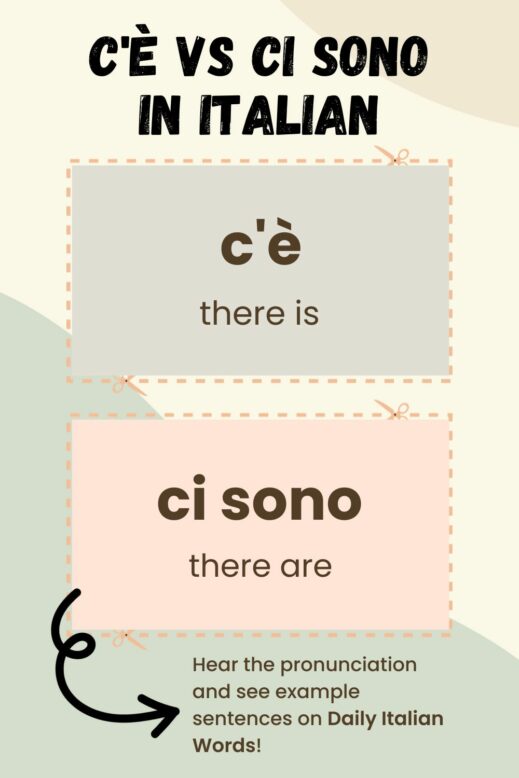When talking about the existence or presence of something in English, we use the expressions there is / there’s (singular) and there are (plural). In Italian, the exact equivalents are c’è (singular) and ci sono (plural). C’è is the contracted form of ci + è.

In informal speech, English speakers tend to use the abbreviation there’s to mean both there is and there are, especially when specific numbers or pronouns such as a lot of or many are involved.
- There’s a person here. = There is a person here.
- There’s three people here. = There are three people here.
- There’s lots of people here. = There are lots of people here.
Not so in Italian – in both speech and writing, you have to make sure to use the singular form with singular nouns and the plural form with plural nouns as in the examples below.
C’è un gatto randagio davanti alla porta d’ingresso.
There is a stray cat in front of the entrance door.
Ci sono tanti gatti nel vicolo.
There are many cats in the alleyway.
Unlike English, there is no need to switch the word order to form a question in Italian. Simply raising the intonation at the end of the sentence is enough!
C’è un mercato in questa zona?
Is there a market in this area?
Ci sono dei mercati a Torino?
Are there any markets in Turin?
If you want to talk about the existence or presence of something in the past, you must use the imperfect forms of è (third person singular) and sono (third person plural) which are era and erano respectively. Notice that ci is abbreviated to c’ with these forms.
C’era un gatto sulla finestra.
There was a cat on the window.
C’erano tanti gatti a casa sua.
There were many cats at her house.
For the future and conditional tenses, the English stays the same for the third person singular and plural (there will / would be) but the Italian changes depending on whether the noun in question is singular or plural.
Ci sarà una festa domani.
There will be a party tomorrow.
Ci saranno tante feste durante l’anno.
There will be many parties during the year.
Ci sarebbe un problema.
There would be a problem.
Ci sarebbero tanti problemi.
There would be lots of problems.
Forming the negative in Italian is very easy. Simply add the word non to the beginning of the sentence, and it’s done!
Non c’è tempo per chiacchierare.
There isn’t time to chat.
Non ci sarà nessuno a scuola.
There won’t be anyone at school.
Non ci sono molti bambini alla festa.
There aren’t many kids at the party.
Using ‘ne’ with c’è and ci sono
Ne is a very important and widely used pronoun in Italian, yet it isn’t particularly easy to translate into English. Depending on the context, it can mean some, of it/them when talking about quantities, or about it/them. For example:
- Do you want some? = Ne vuoi?
- Do you want half (of it)? = Ne vuoi la metà?
- Do you know anything about it? = Ne sai qualcosa?
The reason I’m briefly mentioning ne here is because it often makes an appearance with c’è and ci sono to mean there is / are + a quantity.
Important: Don’t forget that ci transforms into ce when followed by ne, and in the third person singular, ce ne è is contracted to ce n’è, not *c’è ne.
Ce n’è abbastanza. / Ce ne sono abbastanza.
There is enough (of it). / There are enough (of them).
Ce n’è poco. / Ce ne sono pochi.
There is a little (of it). / There are a few (of them).
Ce n’è sono alcuni.
There are some.
Non ce n’è più. / Non ce ne sono più.
There isn’t any more (of it). / There aren’t any more (of them).
Alternative translation: There is none left. / There are none left.
Ce n’è solo uno! / Ce ne sono dieci!
There is only one! / There are ten!
Do you have any questions about using c’è and ci sono? Let us know in the comments below!

Heather Broster is a graduate with honours in linguistics from the University of Western Ontario. She is an aspiring polyglot, proficient in English and Italian, as well as Japanese, Welsh, and French to varying degrees of fluency. Originally from Toronto, Heather has resided in various countries, notably Italy for a period of six years. Her primary focus lies in the fields of language acquisition, education, and bilingual instruction.


